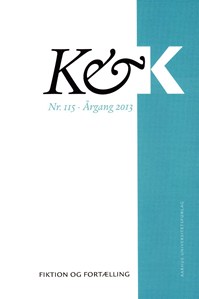NARRATION, VETANDE OCH KOMMUNIKATION - ICKE-MIMETISKA DRAG I FÖRSTAPERSONSBERÄTTANDE
DOI:
https://doi.org/10.7146/kok.v41i115.15881Nøgleord:
Unnatural narrative, fictionality, first person narrative, disclosure functions, narrative communication, narrative audiencesResumé
NARRATION, DISCLOSURE AND COMMUNICATION. NON-MIMETIC FEATURES IN FIRST PERSON FICTIONAL NARRATIVE | This article studies the multi-layered narrative structure distinctive to fiction. The emphasis is on the discoursive and epistemological privilegesthat are associated with third person narration, but which are also manifested in the first person narratives studied in the article. The article analyzes two historical novels, Suomen historia (1998) by
Juha Seppälä, and Kallorumpu (2011) by Eeva-Kaarina Aronen. Both have first person narrators: the largest part of Suomen historia is written like an autobiography, whereas in Kallorumpu the narrator tells about himself, showing and commenting on a film – also featuring himself – to a live audience. Both novels defy the definition of narrative as communication with symmetrical sender–receiver pairs. The very act of telling is unclear in terms of temporal and spatial positioning, and so is the amount and order of narrative levels. The narrators and narrative situations are protean, with tenses, deictic markers and other linguistic and contextual cues oscillating between the narrator’s and the character’s discourse and between narrative audiences. I argue there is a need to revise definitions and terminology to explain non-mimetic, unnatural phenomena in first person fictional narration. I propose the overall concept to be called narratorial functions, and that we divide these into communicative and
disclosure functions, the first ones abiding to the rules of communication, the latter defining them.
Downloads
Citation/Eksport
Hatavara, M. (2013). NARRATION, VETANDE OCH KOMMUNIKATION - ICKE-MIMETISKA DRAG I FÖRSTAPERSONSBERÄTTANDE. K&K - Kultur Og Klasse, 41(115), 139–153. https://doi.org/10.7146/kok.v41i115.15881
Nummer
Sektion
Artikler
Licens
Tidsskriftet følger dansk ophavsret.





